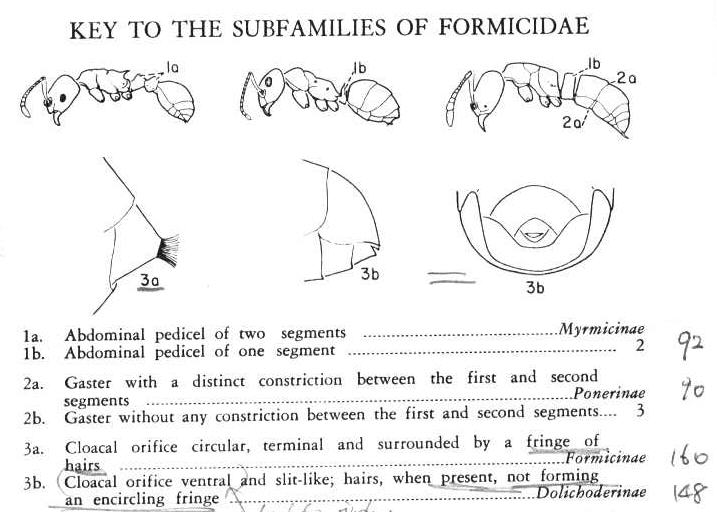How to use key to find Ponera pennsylvanica
|
Taxa remaining
Figure 3. Ponerinae: Ponera pennsylvanica |
|
Ecitoninae
|
|||||||||||||||
|
|
|
How to use key to find Ponera pennsylvanica
|
Taxa remaining
Figure 3. Ponerinae: Ponera pennsylvanica |
|
Ecitoninae
|
|||||||||||||||
|
|
|
| 1. Body with a single reduced or isolated segment (petiole) between the alitrunk and gaster (Figs. 1-3: Wheeler & Wheeler's key below, 1b) |
...2. |
| Body with two reduced or isolated segments (petiole and postpetiole) between the alitrunk and gaster (Fig. 4: 1a). |
...4. |
|
|
|
 |
|
| 2.Gaster with a distinct constriction between the first and second segments. Sting present and usually conspicuous (Fig. 6: 1b 2a). Apex of gaster with a sting; first gastral segment separated from second segment by an extensive, deep, girdling constriction (Fig. 2.2b) |
...Ponerinae |
| Gaster without constriction, sting extremely reduced / absent and never visible without dissection (Figs. 7-8). Apex of gaster lacking a sting; first gastral segment entirely confluent with the second (Fig. 2.2a) |
...3. |
 |
Key sources: modified from Creighton (1950), Wheeler & Wheeler (1963), Francoeur (1973), Holldobler & Wilson (1990), Bolton (1994), Linksvayer (1998) Image sources: from Wheeler & Wheeler (1963), Bolton (1994), Linksvayer (1998), Japanese Ant Database Group (1998)
Ponerinae: Odontomachus bauri
Predatory ant, binding speed of jaw closure is fastest anatomical structure in the animal kindom (0.3-1 millisecond), inside mandibles are huge nerve cells that responsed to pressure on the hair. The mandibles function as snap jaws and can open widely, almost to 180 degrees.
Odontomachus comprises about 50 species and ranges widely, worldwide in tropical and subtropical regions, and in some temperate areas.

Primitive, not regurgitate, queen forage for food for 1st brood, timid, not aggressive, monomorphic: worker is similar with female in size, uniformly carnivorous, pupae in cocoon, thief ant, always associate with other ants, nest in acorns or nuts, prefer dry open habitats, e.g. woods edge, slow moving, feed on small arthropods
Very timid and moves in a characteristic serpentine fashion. The fenestra (small nearly circular "window" through which light passes) on the ventral surface of the petiole ischaracteristic of the genus. It was fairly abundant in every habitat wesurveyed. We nearly always found this species in close association with a variety of other ant species (in fact, the fairly cryptic Ponera while observing another species' nest). Perhaps this species preys upon other ant's eggs and larvae like the thief ant Solenopsis molesta.
Around 30 species have been described, distributed mainly in the Indo-Australian Region. Ponera species nest under stones, in rotting logs, and in the soil.
Ponera pennsylvanica
Buckley (Ponerinae: Ponera
Latreille)
(S)1.jpg)
.fa(S).jpg)
.fa(F).jpg)
(S).jpg)
.ma(F).jpg)
Profile view of a worker, alate female reproductive.
Face view of a female reproductive, alate male reproductive, and face view of a male reproductive.